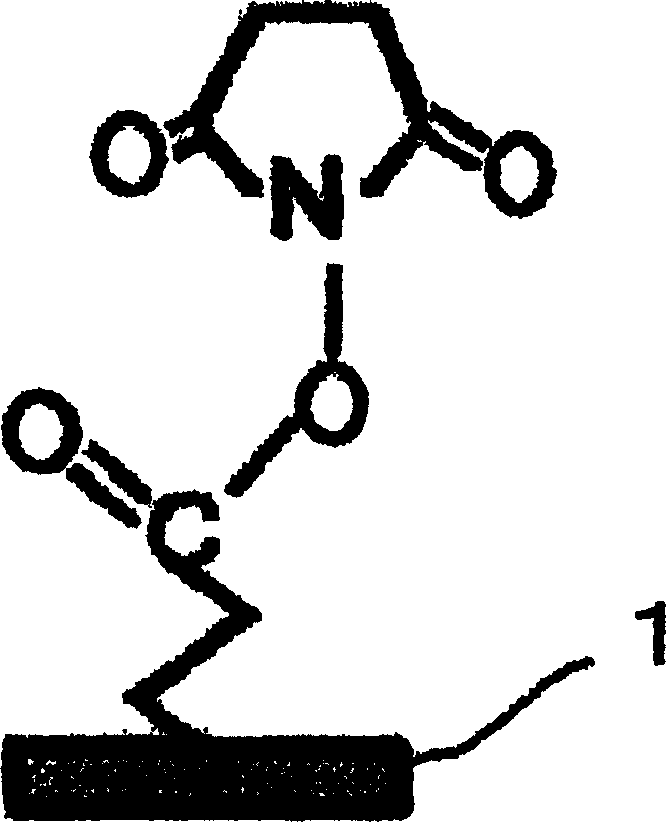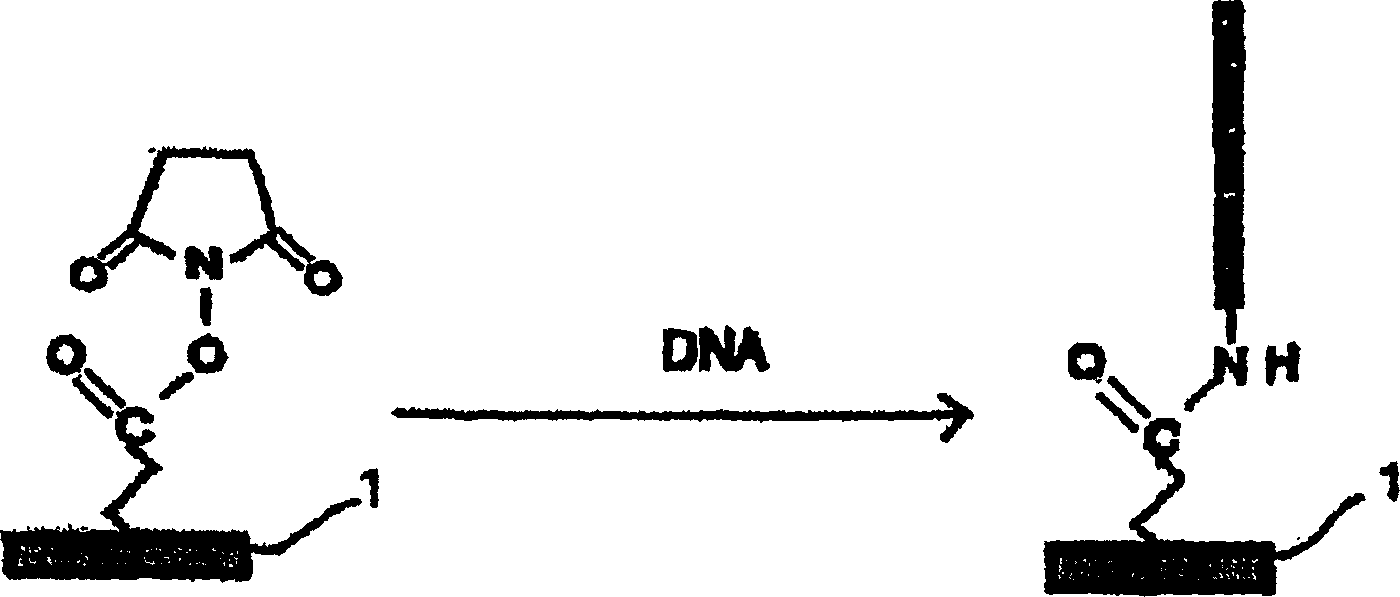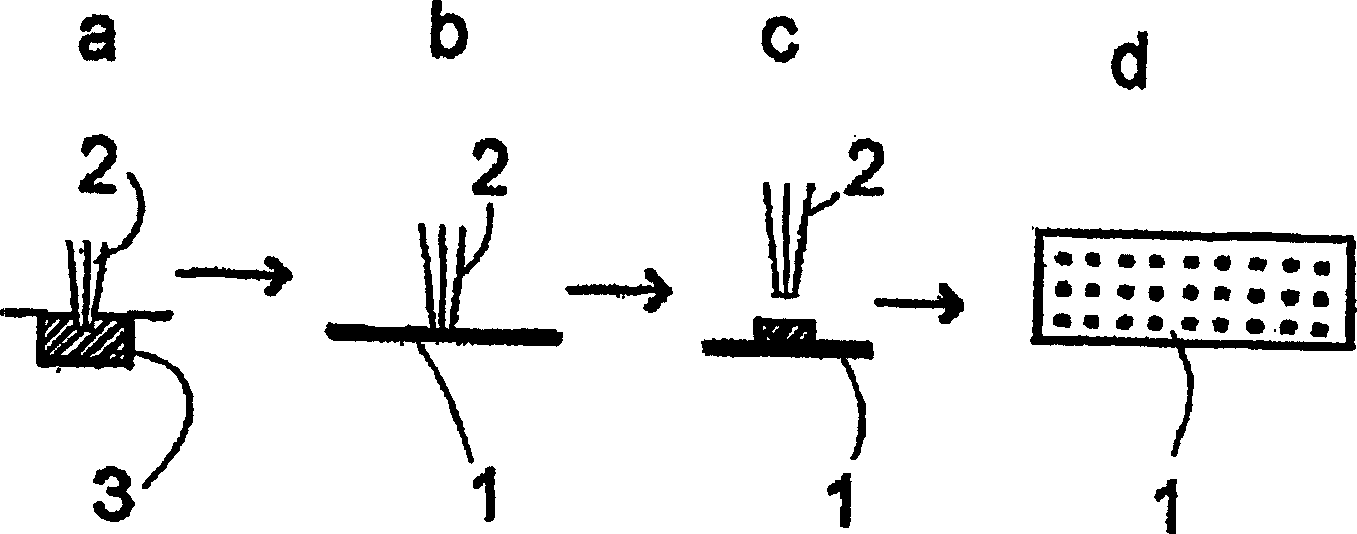Substrate activation kit and method of detecting DNA or the like by using the same
A kit and substrate technology, applied in the field of detection of DNA or protein, can solve problems such as harmful active sites and difficulties in accurate detection of DNA
- Summary
- Abstract
- Description
- Claims
- Application Information
AI Technical Summary
Problems solved by technology
Method used
Image
Examples
Embodiment 1
[0089] Procedures for using soft diamond-coated glass slide substrates are discussed below.
[0090] (1) Preparation of soft diamond-coated glass slides
[0091] First, a 25nm thick DLC film was deposited on a 25mm wide, 75mm long, and 1mm thick glass sheet by ionized vapor deposition, using a gas mixture of 95% by volume of methane and 5% by volume of hydrogen.
[0092] Then, the surface of the glass slide is chemically modified.
[0093] Irradiate the surface of the glass substrate with a high-pressure mercury lamp in ammonia gas for 10 minutes for ammoniation, and then immerse the substrate in a solution of succinic anhydride dissolved in N-methylpyrrolidone for 60 minutes to obtain a soft glass substrate with carboxyl groups on the surface. Diamond-coated glass slides.
[0094] After derivatizing the carboxyl groups on the surface of the substrate into active esters with N-hydroxysuccinimide, as figure 1 The method shown immobilizes DNA on soft diamond-coated glass slides...
Embodiment 2
[0153] Soft diamond-coated glass slides similar to those used in Example 1 were first activated by a method similar to that used in Example 1. Spotting was performed with a solution similar to that in Example 1, except that 10% glycerol was used instead of formamide.
[0154] (4) incubation
[0155] For incubation, first place the sealed box filled with saturated aqueous sodium chloride solution in an incubator set at 4°C for about 1 hour to ensure that the temperature of the entire sealed box reaches 4°C. Then take out the airtight box from the incubator, put the substrate, and pay attention to avoid contacting the saturated sodium chloride aqueous solution (the substrate is placed on the protruding part of the bottom) when putting it in. Next, put the sealed box back into the incubator and let it stand for 1 hour. The sealed box containing the saturated aqueous sodium chloride solution was then placed in an incubator set at 65° C. for 1 hour, and then dried. After drying,...
Embodiment 3
[0161] First, a soft diamond-coated glass slide similar to that used in Example 1 was activated by a method similar to that in Example 1. Spotting was performed with a solution similar to that in Example 1, except that 10% glycerol was used instead of formamide.
[0162] (4) incubation
[0163] For incubation, first place the sealed box filled with saturated aqueous sodium chloride solution in an incubator set at 4°C for about 1 hour to ensure that the temperature of the entire sealed box reaches 4°C. Then take out the sealed box from the incubator, put the substrate into it, and avoid contacting the saturated sodium chloride aqueous solution when putting it in (the substrate is placed on the protruding part of the bottom of the sealed box). Next, put the sealed box back into the incubator and let it stand for 1 hour. Then put the sealed box filled with saturated aqueous sodium chloride solution in an incubator set at 65° C. for 1 hour, and then dry it. Add 0.5% agarose gel...
PUM
| Property | Measurement | Unit |
|---|---|---|
| thickness | aaaaa | aaaaa |
Abstract
Description
Claims
Application Information
 Login to View More
Login to View More - R&D
- Intellectual Property
- Life Sciences
- Materials
- Tech Scout
- Unparalleled Data Quality
- Higher Quality Content
- 60% Fewer Hallucinations
Browse by: Latest US Patents, China's latest patents, Technical Efficacy Thesaurus, Application Domain, Technology Topic, Popular Technical Reports.
© 2025 PatSnap. All rights reserved.Legal|Privacy policy|Modern Slavery Act Transparency Statement|Sitemap|About US| Contact US: help@patsnap.com



